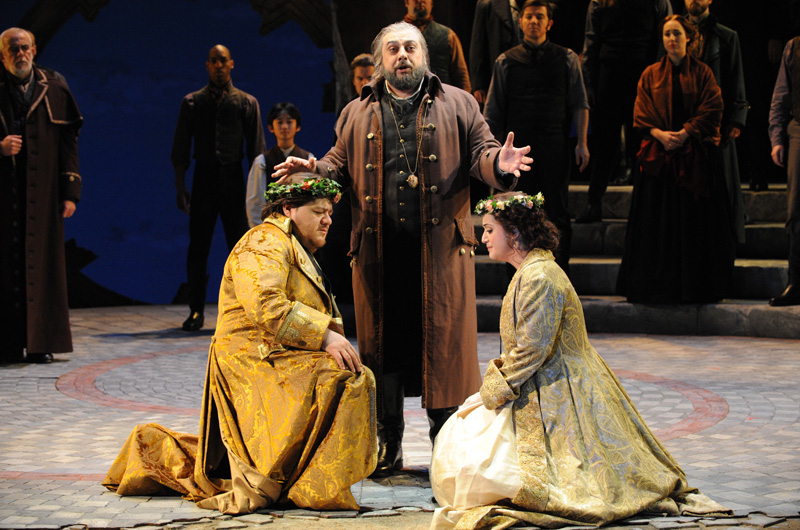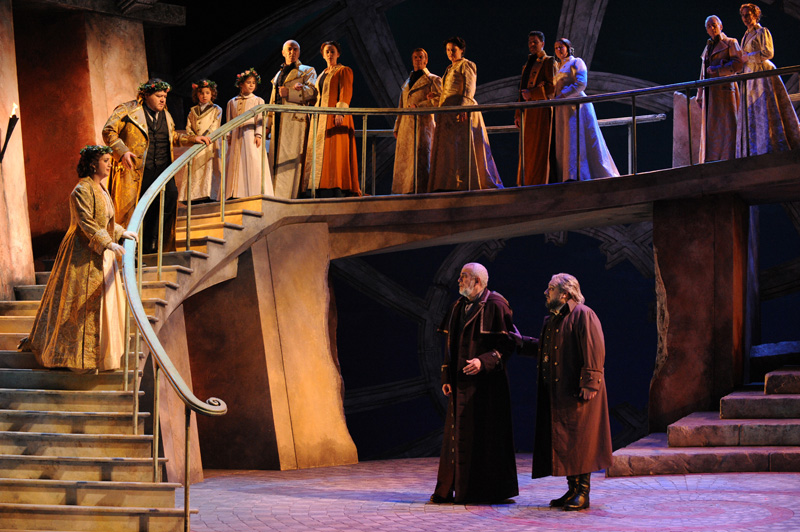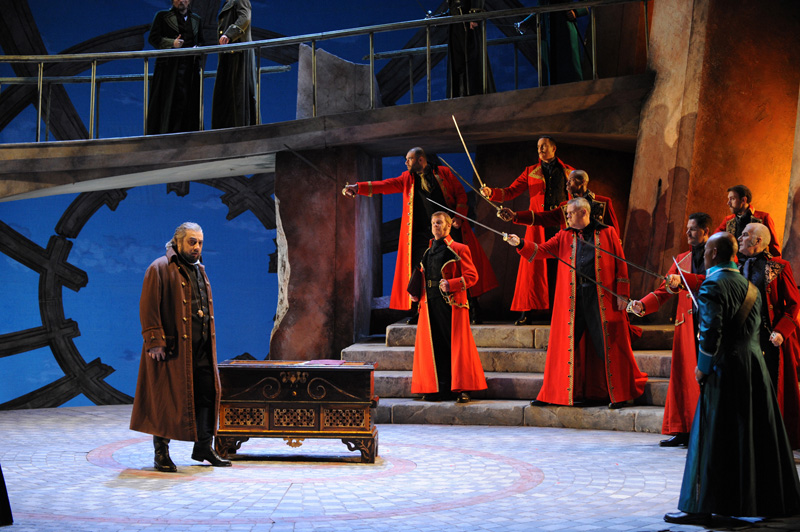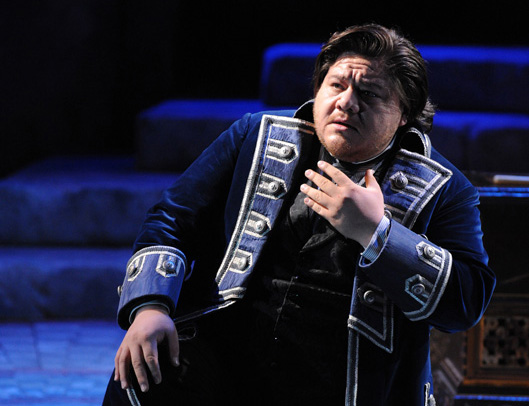★★★½☆ Glorious music-making carries the day despite a clunky plot and static staging.
Joan Sutherland Theatre, Sydney Opera House
July 26, 2016
Moffatt Oxenbould’s production of Verdi’s politically-charged opera Simon Boccanegra premiered in 2000 as part of Sydney’s Olympic Arts Festival, with Simone Young conducting. This is the first time Opera Australia has revived it since, with director Matthew Barclay at the helm.
It’s not the most dynamic production, it has to be said, and with its convoluted, sometimes half-baked plot, you can see why the opera itself is not among Verdi’s most popular and regularly performed works. However, there is some magnificent music and the quality of the singing and orchestral playing makes for a rewarding night.
Set in 14th-century Genoa, Simon Boccanegra is a dark opera with a complex, sprawling story in which the personal and the political intertwine. Equal parts political thriller, historical drama, melodrama and romance, it takes place in a treacherous world where men jostle for power and animosities fester. The cut and thrust of intrigue, revenge and retribution is leavened by love, moral redemption and reconciliation.

Diego Torre, George Petean and Natalie Aroyan
Verdi and librettist Francesco Maria Piave based it on a Spanish play by Antonio García Gutiérrez (whose play El trovador Verdi had adapted for his opera Il trovatore) about a real-life historical figure called Simone Boccanegra, a former pirate who was elected Doge of Genoa in 1339 and died in 1363, allegedly poisoned by rivals.
In a prologue, Verdi’s opera introduces us to Simon Boccanegra, a plebeian who has found fame defeating African pirates who threatened the city’s sea trade. Reluctantly elected Doge of Genoa in a coup orchestrated by his friend Paolo, Boccanegra’s hope of marrying his lover Maria is dashed when she is found dead. His grief is compounded by the fact that their young daughter has gone missing. Maria’s patrician father Jacopo Fiesco swears that there will be no peace between them until his granddaughter is found.
Twenty-five years later, Boccanegra is still the powerful Doge but a troubled man. Meanwhile, the exiled Fiesco, living secretly under the name of Andrea, has adopted a young girl and raised her as his daughter Amelia not realising she is actually his granddaughter.
Now, just as Boccanegra finally discovers his lost daughter, his political enemies – including Amelia’s lover Gabriele Adorno – gather against him, while the ruthless, duplicitous Paolo poses a threat closer to home.

Diego Torre, Natalie Aroyan, Giacomo Prestia, George Patean and the Opera Australia Chorus
When the opera premiered in 1857, it was a flop. The plot was deemed too complicated and Verdi himself described it as “cold and monotonous”. More than two decades later, Verdi revised the opera extensively with composer-lyricist Arrigo Boito (who would go on to write the libretti for Verdi’s Otello and Falstaff). Boito tightened the text, sharpened the drama and added the renowned Council Chamber scene, while Verdi reworked the music. The new version premiered in Milan in 1881 to greater acclaim and the opera gained fresh recognition during the 20th century.
The story is still rather convoluted, with plot turns that aren’t terribly well developed or fully explained including political revolts between warring Italian factions and an abduction that doesn’t feel as dangerous as it should.
However, there is much to enjoy in the score from surging, darkly coloured music that seethes with fury and testosterone to the shimmering sound of the sea in Amelia’s opening aria; from emotionally intense duets to complex ensemble numbers, particularly the magnificent Council Chamber scene that brings Act I to a rousing climax, with solo lines by the central characters soaring over a large, powerful ensemble.
Oxenbould decided to move his production out of the 14th century and set it around the time that Verdi wrote it in an abandoned place by the sea where an Italian community gathers to re-enact a story from their past as a reminder to pursue love, peace and reconciliation. Thus, at the start of the production, costumes are handed out from a couple of large chests to the principal players. But after that, little more is made of the device.
Peter England’s off-kilter set features a cobbled piazza with steps sweeping up from one side of the stage to an overhead walkway, along with wooden pillars and a vista of the sea and sky through the large round window of a decaying building. Dark, heavy and imposing, it’s not the most attractive setting. Visually, the production comes to life during the Council Chamber scene when Russell Cohen’s costuming featuring full-length red coats for some of the men, green hues for others, blue velvet with gold braid for Adorno and gleaming gold for Boccanegra makes for a painterly effect, with lighting by Nigel Levings.
The programme describes Barclay’s production as “a new take” on Oxenbould’s original but it still feels rather static, performed in a declamatory style. However, after a slow start, the production builds strongly thanks to some exciting singing.

George Petean and the Opera Australia Chorus
Boccanegra is one of Verdi’s greatest baritone roles. A powerful but essentially decent man, who having been reunited with his daughter longs for political peace and a united Italy, the character is well-developed musically and dramatically. Romanian baritone George Petean (who played Boccanegra in Rome for conductor Riccardo Muti and director Adrian Noble in 2012, among other productions) is superb in the role. His warm, resonant voice is emotionally expressive and he has a strong dramatic presence.
His Act III aria with Giacomo Prestia’s Fiesco, when the two foes are finally reconciled, is very moving as is his aria Piango su voi, sul placido raggio del Vostro clivo (Sadly I see the sweet bloom of spring on our nature hillsides) in which he pleads for peace and unity.
The opera touchingly explores the love between a parent and a child – first Fiesco’s grief at Maria’s death and then Boccanegra’s joy at finding his daughter. Verdi himself lost his wife and two young children to illness within the space of a year, so he was doubtless able to draw on that experience.
Italian soprano Barbara Frittoli, who has played Amelia at the Metropolitan Opera in New York, had begun rehearsing in Sydney but had to withdraw at the last minute (for family reasons) and was replaced by Armenian-Australian soprano Natalie Aroyan, an OA principal, making her debut in the role. After a tentative start, with a lot of vibrato in her voice, Aroyan settles into the role and has some shining moments.

Diego Torre
Mexican tenor Diego Torre (who became an Australian citizen in January) exudes great passion as Amelia’s lover Gabriele Adorno. He creates an ardent, noble character and his velvety, Italianate tone is thrilling. Italian bass Giacomo Prestia is equally impressive as Boccanegra’s sworn enemy, the imposing, implacable Fiesco, Ever the convincing villain, Australian baritone Warwick Fyfe (who reprises the role of the anorak-clad Alberich in OA’s Ring Cycle in Melbourne later this year) plays Paolo with a cold, slippery menace, his fine acting matched by powerful vocals.
Under Italian Renato Palumbo, a highly regarded Verdi conductor, the Australian Opera and Ballet Orchestra gives an excellent, exhilarating performance of the score. And so, despite a pretty ordinary staging and the convoluted, clunky plot, some glorious music-making carries the day, offering a welcome opportunity to see a rarely performed opera.
Opera Australia’s Simon Boccanegra plays at the Sydney Opera House until August 13












Comments
Log in to join the conversation.